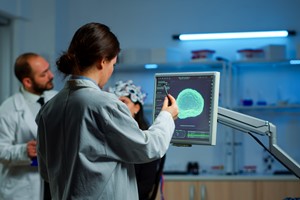Driving factors propel market growth
Medical demands keep growing driven by worldwide ageing populations, higher prevalence of chronic diseases, and rising expectations for healthcare. Global healthcare systems are under strain with staff shortages and financial sustainability while facing rising demands and expectations. The limited healthcare resources are struggling to meet the ever-growing demands.
Fuelled by rising medical demands and technological innovations, the global healthcare equipment market has been growing at double the pace of the global GDP since 2016.
These factors will continue to drive robust growth of the global healthcare equipment market.
Adoption of the Quadruple Aim of healthcare
The Quadruple Aim is a guideline widely adopted among healthcare providers to optimise outcomes for stakeholders. It demands health systems to achieve higher efficiency and better clinical outcomes at lower costs.
Technology innovations are pivotal to achieving the aim. Medical device makers have been striving to develop technologies and solutions, supporting healthcare providers to improve efficiency, enhance the clinical outcome and reduce costs.
Four trends emerge in global healthcare
Powered by technological innovations to tackle health system challenges alongside the rising role of patients in healthcare practice, the following trends emerge and accelerate with the outbreak of the COVID-19 pandemic.
Consumerisation: As seen in other industries, consumerism is taking hold in the healthcare industry. Patients or consumers are showing increasing preference for home setting solutions for the sake of more convenience and better information access. Consumer medical devices, including various types of wearables constantly tracking health indicators, will continue their robust growth in the foreseeable future. The line between consumer technology and medical devices is increasingly blurring.
From the healthcare providers’ side, the recent technology advancements propel the trend of healthcare, shifting from hospital care to home care. Home health is becoming a fast-growing business with home healthcare providers flourishing.
Digital transformation: During the COVID-19 pandemic, contactless and virtual care became ubiquitous among healthcare providers. Accelerated by the COVID-19 pandemic, telemedicine will continue to rise.
As per Omdia’s survey, healthcare providers worldwide have been increasing their spending on digital transformation. The Omdia survey reveals that since the outbreak of the COVID-19 pandemic, healthcare providers have ramped up their adoption of AI and telemedicine, and they plan to further expand the adoption in the coming years.
Automation: Healthcare is a labour-intensive sector. Under-resourced professionals are struggling to meet ever-growing medical needs. Technology can lend a strong hand to healthcare workers.
Healthcare robots, like nursery robots and rehabilitation robots, can assist with patient care. Robotic process automation (RPA) can replace labour in operational areas by learning and repeating routine tasks that humans perform, such as appointment scheduling and claiming process operations.
Decentralisation: The recent technological innovations including devices constantly tracking and monitoring health, online platforms, and apps offering medical consultations, have greatly expanded access to health services and health data.
Increased data sharing and interoperability among healthcare providers break boundaries across practices and locations. Instead of heavily relying on nearby hospitals for consultations, diagnoses, and treatments, patients will have more choices and information sources to manage their health, shifting from centralised care to omni, decentralised care.
The four trends are interconnected:
- Digital transformation requires connectivity among devices.
- The health data generated by homecare devices can only be well tapped for its huge potential if connected to healthcare providers for further analysis.
- Automation devices will play a big role in improving clinical outcomes if the data is integrated into the monitoring and treatment system.
- The more decentralised healthcare is, the more connectivity and collaboration are required to improve the healthcare outcome and operational efficiency.
The outlook of the healthcare industry is changing
The healthcare ecosystems and social dynamics are changing. Technologies are striding forward. Healthcare will present a new outlook in the coming decade.
In traditional healthcare:
- Clinical outcomes have largely fallen on the pharmaceutical firms through medication.
- Healthcare providers have found staff shortages to be a major obstacle in terms of service quality.
- High entry barriers have been protecting the incumbents of the healthcare industry and hampering the thriving of newcomers.
In future healthcare:
- Medical devices will play an increasingly important role in improving clinical outcomes and operational efficiency.
- Medical devices will become much smarter. Technological innovations centred around the trend of consumerisation will demand the smartisation and connectivity of medical devices. Advanced sensing technologies will play a big part in the healthcare sector’s future.
- There will be more stakeholders in healthcare. The healthcare equipment market will meet new entrants with non-healthcare backgrounds. Non-medical competitors, which win the preference of consumers with disruptive technologies, will increasingly pressure traditional medtech companies.
Technology has lagged in the healthcare industry compared with other industries. The future of healthcare will be empowered by technologies with patients at the centre of the ecosystem.











